About the Application
This space is designed to hold layout and content suggestions for a mobile application concept. The intention of the app is to assist with issues of diversity and inclusion on film sets and in game studios.
The information is presented in a mixed form that includes both narration and example. The flow of information and background processes are not addressed directly, as the technical design of the object will be affected by the platform(s) on which it is eventually designed. That being said, desired functionality of some algorithms is addressed. The layout of some, but not all, screen components are presented. The way connectivity affects content is also discussed.
Early plans included using Pencil Project to arrange the graphic elements:
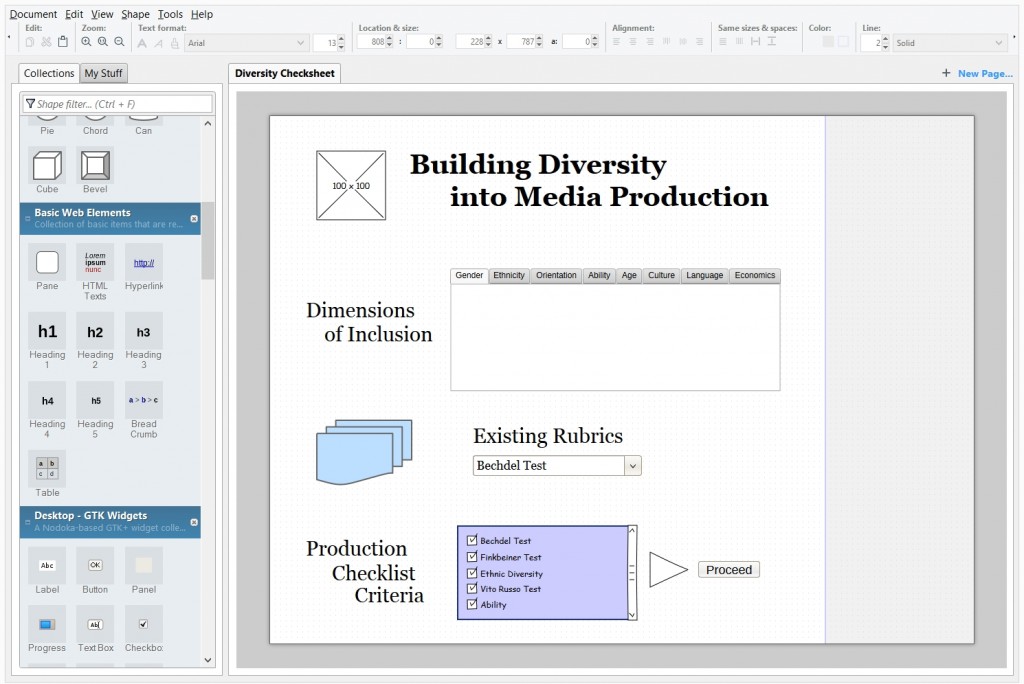
After completion of the written portion of the thesis, however, some tools for development of the digital part (this site) have changed. For one thing, the artefact was not relegated to a subdomain of another site. Instead a dedicated site was created, which was good in that it encouraged thinking more expansively in order to make use of the space, rather than simply filling the cracks of an existing project.
For another, some of the tools which had been planned for heavy use – image mapping plugins, form making plugins, etc. – ended up falling into minor roles or were discarded altogether. Instead of the aforementioned options, a WordPress plugin that covers many bases was used. It makes several simple, yet highly useful, design options available at the click of a button: Shortcodes Ultimate. Tabs, accordion menus, and other handy features trumped much of the messiness of the other alternatives. Such is life in the digital world.
It is important to mention who the intended audience for this app is. It is NOT aimed at people who still need to be convinced of the benefits of diversity. Although there will be links to resources about various topics as part of the app, including some that help answer the “why”, this is not meant to change anyone’s mind. Rather, it is meant to support those who recognise in a general way that diversity is good, but need a little help now and then with the specifics of implementing changes in a practical manner.
Another important thing to mention is the caveat that none of this is meant to be legal advice. It is merely suggesting ways that a user or their organisation might adjust how they approach their processes. Questioning things that we take for granted – such as the gender and ethnicity of heroes and leaders which, in many contemporary tales, defaults to cisgender, straight, white, and male – is an important component to examine. How hiring decisions are made is another. The latter often crosses into territory where litigation relating to discrimination occurs, so it is best to carefully consider how to most appropriately implement any changes before enshrining them in company policy.
Most of all, this is about learning and questioning together. Not only does this encourage positive personal growth, it leads to a more creative, innovation, and productive world. As Albert Einstein is alleged to have said, “Learn from yesterday, live for today, hope for tomorrow. The important thing is not to stop questioning.”
As a final note, this site has been optimised for the desktop version of the Chrome browser. Complete functionality for other browsers cannot be guaranteed. The WordPress theme is responsive and works reasonably well in mobile browsers. Smaller screens do sometimes lead to undesirable distortions and text wrapping.
Opening Screen
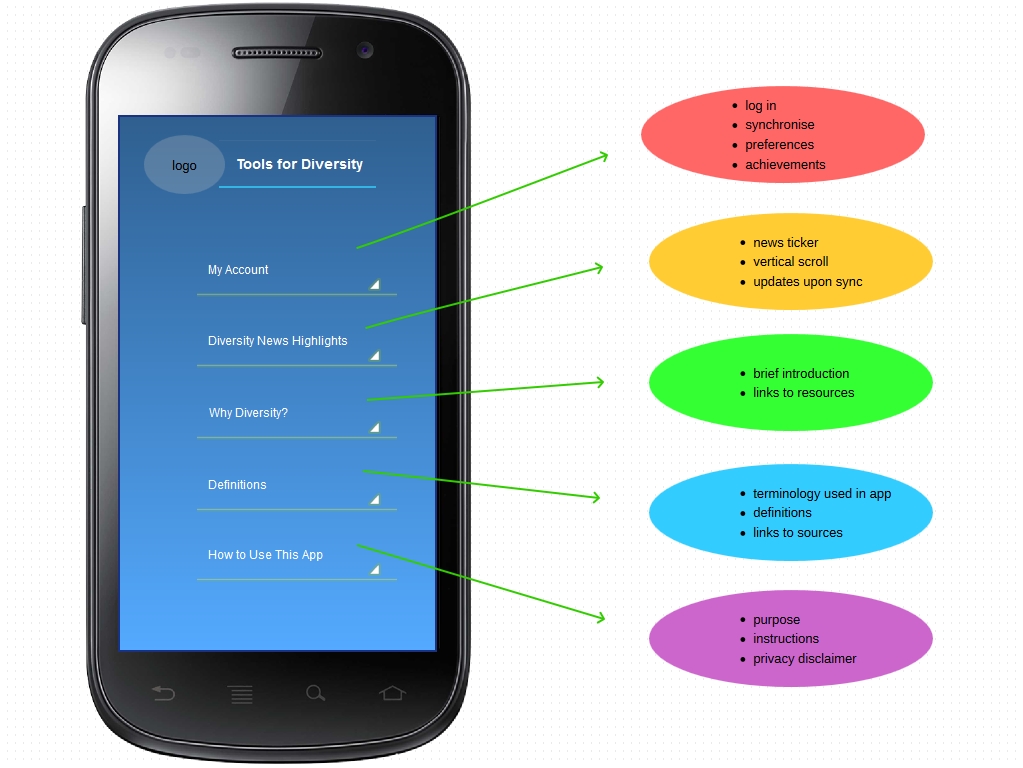
My Account
Initially, there will not be an option to sign in, so this is a snapshot of later development. The application will come out-of-the-box with generic information. Later, options to log in to register preferences, synchronise data across devices, track progress on scripts and projects, and, if desired, earn achievement badges will be offered.
Although the illustration makes use of a graphical element which indicates an expanding menu, this is only one possible way it could ultimately function. Arrows indicating the option to swipe into an expanded menu are another.
If the user is already logged in, the home screen will display different options, possibly to include Check Lists, Sync News, Sync Account, My Projects, Breaking News, and Anecdotes. Until proper sign in ability is created, the “My Account” menu would be replaced with “Check Lists”, which would display the I Am…, Characters, Crew, Cast, and Anecdotes options.
Diversity News Highlights
There is a larger section deeper into the application for news and current affairs. The home screen will also feature curated highlights if the user is online and chooses to synchronise the news ticker. It will feature a slow, looping vertical scroll that will only be visible should the user choose to expand the section.
Why Diversity?
The purpose of this app is not to convince anyone of the positive reasons for making diversity an integral part of business planning. Rather, the intended audience are those who already recognise this to be so, but are searching for the best methods by which to institute change. The importance of the question, however, cannot be overlooked.
A simple online search for “why diversity is important” quickly brings up articles from authoritative sources such as universities and established business publications. Among the reasons listed are: access to a larger talent pool, varied viewpoints, increased problem solving ability, reduced discrimination, ethnic shifts in population, increased buying power of minorities and women, opportunities in niche markets, respecting the values of a company’s customer base (which is reflected in customer loyalty), and avoiding costly marketing mistakes. These are just the business reasons.
While it is often easier to sell prioritising diversity to companies based on financial data, the positive social impact of increased diversity is huge and far-reaching, if not always as easy to measure. Increased empathy, inspiration to innovate and achieve (something which tends to benefit everyone), higher levels of health, lower levels of poverty and illness, and many more. Smaller companies may not have an easy time devoting resources to community outreach programs, but the internal atmosphere of a healthy, diverse company will often be felt externally through the quality and character of their products. Even being able to call your company diverse has a positive impact on the community.
The issues are multi-layered and complex. They will not be solved through simple use of a mobile app. Yet having quick access to reminders of things we often overlook about the perspectives of people with different experiences than our own can be an important tool. Since storytellers and entertainers have a huge impact on how we relate to the world, bringing this awareness to creators is a vital step.
Definitions
Defining a Common Language
There are many more nuances and fine points than can comfortably fit into a mobile application when it comes to the language of individuality and equality. These are, in brief, an explanation of how some of these terms are used throughout the app and accompanying website, with an acknowledgement that many of them are used in a way which reflects the author’s own filters. Users will see these terms hyperlinked to the definition when used elsewhere in the application.
1. privilege – “an invisible package of unearned assets” or “a set of unearned benefits given to people who fit into a specific social group”
2. race and ethnicity – “race is associated with biology, whereas ethnicity is associated with culture”; further, “…races are genetically distinct populations within the same species; they typically have relatively minor morphological and genetic differences. Though all humans belong to the same species (Homo sapiens), and even to the same sub-species (Homo sapiens sapiens), there are small genetic variations across the globe that engender diverse physical appearance”; although different, these terms are often used interchangably
3. nationality – “a: national status; specifically: a legal relationship involving allegiance on the part of an individual and usually protection on the part of the state; b: membership in a particular nation”
4. sex vs. gender – “‘sex’ denotes human females and males depending on biological features (chromosomes, sex organs, hormones and other physical features); ‘gender’ denotes women and men depending on social factors (social role, position, behaviour or identity)”
4.1. cisgender – “denoting or relating to a person whose self-identity conforms with the gender that corresponds to their biological sex”
4.2. transgender – “umbrella term for people whose gender identity and/or gender expression differs from what is typically associated with the sex they were assigned at birth”
4.3. gender fluid – “[not] feeling like you’re at one end of the spectrum or the other”
5. sexual orientation – “a person’s sexual identity in relation to the gender to which they are attracted; the fact of being heterosexual, homosexual, or bisexual”
6. ableism – “discrimination against people with disabilities”
7. ageism – “discrimination or unfair treatment based on a person’s age”
8. prejudice – “an unfair feeling of dislike for a person or group because of race, sex, religion, etc.; a feeling of like or dislike for someone or something especially when it is not reasonable or logical”
9. bias – “a tendency to believe that some people, ideas, etc., are better than others that usually results in treating some people unfairly”
10. intersectionality – “…intersections between forms or systems of oppression, domination or discrimination. An example is black feminism, which argues that the experience of being a black woman cannot be understood in terms of being black, and of being a woman, considered independently, but must include the interactions, which frequently reinforce each other.”
11. microaggressions – “…the everyday encounters of subtle discrimination that people of various marginalized groups experience throughout their lives.”
Note: all quotations other than the definition of microaggressions have been cited in the thesis. The definition for microaggressions was taken from the APA Psychology Benefits Society blog.
How to Use This App
This application is designed to be a series of questions content creators can ask themselves to increase objectivity about their subject matter, their assumptions, and how they can make small, but significant, changes that affect the perception of diversity in popular culture. There is no finger wagging, nor are there any attempts at shaming. Rather, the check lists should be read as “Have you considered the following?”
Enter as much or as little information about yourself as you choose, or go directly to the section most relevant to your current situation. No personally identifiable information will be recorded, though later versions may offer the (completely optional) chance to create a profile, save projects, and earn achievements.
The author welcomes your constructive criticism and suggestions. If you’d like to submit a personal story or anecdote, please go to the contact page on SuddenOnset.eu: https://suddenonset.eu/contact/
Thank you for making diversity and inclusion priorities in your production!
How I Describe Myself
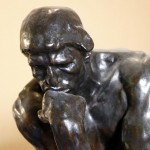 Here users will be given the opportunity to select their personal descriptors in order to address the issue of implicit bias. By identifying some things that typically affect our perceptions of the world, these issues can be brought into focus and examined.
Here users will be given the opportunity to select their personal descriptors in order to address the issue of implicit bias. By identifying some things that typically affect our perceptions of the world, these issues can be brought into focus and examined.
A useful way to think of it is perhaps by using the analogy of the red and blue coloured 3D glasses: each side filters out the wavelength of light with which it corresponds, allowing the eye to only pick up the remaining colours of the spectra.
Input: Self Descriptors
In this section, users will have the chance to select common self-descriptors. The purpose is to consider how circumstances frequently experienced by similarly self-describing people may affect their perceptions. This section, perhaps more than any other, may be somewhat fraught, as one of the big considerations is the concept of privilege. When not handled delicately, it is very easy to put people on the defensive. Therefore, this area will be subject to frequent editing and updating to adjust for approach and tone as feedback from testers is received.
- Gender
- Sexual Orientation
- Ethnicity and Race
- Nationality
- Age
- Economic Status
- Education Level
Output: Have You Considered?
Ideally, an algorithm will be developed or borrowed from existing applications that will allow a tailored response to the selections made above. The response would come in the form of a list of things that may affect a person’s perception about what is “normal” in the world. (Note: it is not necessary to make a selection for every category.) An example of a possible response:
Have you considered the following?
Your self-descriptors of ‘cigender, male, bisexual, of European descent living in North America, with a post-secondary education’ indicate that some issues to pay particular attention to are:
- gender pronouns as they apply to transgender individuals
- gender pay gaps
- ignoring or speaking over female colleagues
- cultural appropriation
Each of the bullet points would be hyperlinked to sections with more information on the particular topic.
My Professional Role
Similarly, an algorithm for things to consider with regards to job descriptions would come into play. Upon further development of the application, the two algorithms – self-descriptors and job roles – could be used in concert to provide even more finely tuned results.
In this section, we consider where a user’s work fits into the equation. Where in the creative process does their input fall? Is it early in the brainstorming and idea formation stage before hiring has begun? Are they part of a company’s board, someone who sets policies about hiring practices or community outreach? Is it during character design and development? What about marketing and cross-promotion? Localisation? All of these roles, and many more, can influence the way a product is designed and presented. This, in turn, affects the product’s reception, popularity, reach, and penetration into certain markets.
Film sets and game studios have a number of things in common, but there are also striking differences. For example, other than occasional reference material, the percentage of location shots required for a video game tends to be significantly lower than that required for a feature film. However, there are writers, directors, producers, accountants, marketing people, and managers of every sort in both industries. Yet even within these definitions, the array of functions is staggering.
For example, there are differences types of producers: line producers often bridge the gap between logistics coordinator and human resource manager on set; creative producers assist, as the title would suggest, with creative decisions, often overseeing script development and facilitating communication between other teams and producers; while executive producers often deal with finances, sometimes to include contributing to the film’s budget. A showrunner may have a blend of creative, logistic, and staffing duties, and is sometimes referred to as an executive producer. On top of this, any professional in either of these fields may find their duties varying from project to project to project.
In short: it’s difficult to write a compact list that encompasses all of these roles. Therefore, there will be overlap, gaps, and lots of wiggle room in the categories below. Yet, because of this, it is quite easy to conceive of specialised versions of a diversity application for particular markets. Something to consider for the future.
Input: Job Title
Some categories to consider:
- Writers
- Producers
- Directors
- Hiring and Personnel Managers
- Character Creators and Concept Artists
- Engineers and Technical Roles
- Animators
- Marketers and Public Relations Staff
- Team Managers
- Accountants, Payroll Managers, and Line Producers
Users will have the option of checking more than one category. Additionally, this list can have more categories and sub-categories added to it as time goes on.
Output: The Impact You Can Have
Sample output:
Opportunities for Positive Impact
Your job title(s) of ‘writer, character creator’ indicate that some areas in which you can have a particularly positive impact are:
- creating a cast that is correctly representative of the population
- the option to create unique title characters who eschew steretypes
- building character profiles and story arcs with richness and depth
- visually portraying characters in ways that are respectful and inspiring
- language parity
- cultural accuracy
As with the personal descriptors, each of the bullet points would be hyperlinked to sections with more information on the particular topic.
How You Represent the Population
This section is an example of what a user might see by following one of the links from the output of the “I Am…” screen, particularly for those in character creation roles. It will also feature as one of the major categories that can be accessed from Level 1 and 2 menus. It is important to have it as a primary category for ease of accessibility, as this a major power node in the storytelling process.
Taking advantage of the multiple platforms for information delivery available through mobile technology allows information to be presented in visually appealing and easily understood ways. Yet size of the installed application is always something that must be taken into account. One possible way this could manifest is that a screen like this one could have a space for a video that streams when connected to wifi (or data, if that option is enabled), while also including the text of a transcript whether or not the app was connected. With permission and/or proper licensing, including informational videos from organisations like the Geena Davis Institute on Gender in Media are a great option.
Graphics representing the contrast in gender representation, race, and other issues will also be featured in this section.
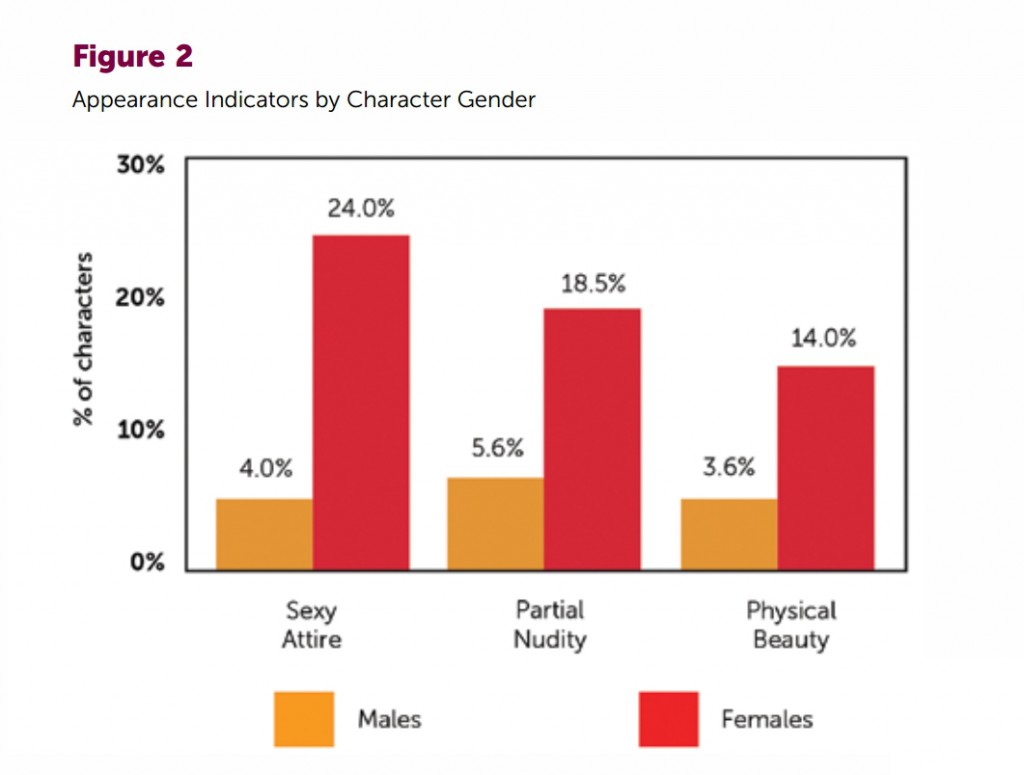
Above graph by the Geena Davis Institute on Gender in Media.
Parity of Representation
This is where metrics like the Bechdel Test come into play. Writers, story editors, directors, producers, members of creative teams, and other players can have an impact on this at any point in the process. In most cases, the earlier it is, the better, as this allows for course corrections before any more of the budget gets spent.
This is one of the central ideas of the application: that externally established metrics can be broken down into simple check points to get a sense of whether or not a production is headed in the right direction when it comes to diversity. Not all metrics are created equally, so ticking all the boxes does not necessarily mean content creators are in the clear. They are here to assist in conscious decision-making and mindfulness.
Humour is a great way to get people to engage, as is a sense of accomplishment. Should users register an account and create individual projects, passing tests of this nature could result in a list of “achievements” with accompanying badges, similar to reward systems in many role playing games.
Gender Balance: The Bechdel Test
In 1985 cartoonist Alison Bechdel rather facetiously introduced a measure of gender representation in films in one of her comic strips. She had been discussing it with her friend, Liz Wallace. It has become known as the “Bechdel test” or the “Bechdel-Wallace test”. It is important to note that successfully checking the boxes does not mean equal representation of gender, but it is a step in the right direction.
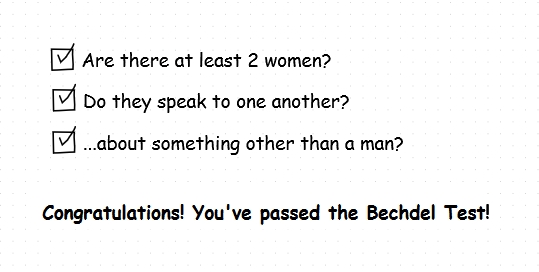
LGBTQIA: The Vito Russo Test
GLAAD (formerly the Gay and Lesbian Alliance Against Defamation) co-founder, film historian, and author of The Celluloid Closet, Vito Russo created a check list based on the Bechdel Test to address the representation of LGBT characters in films.
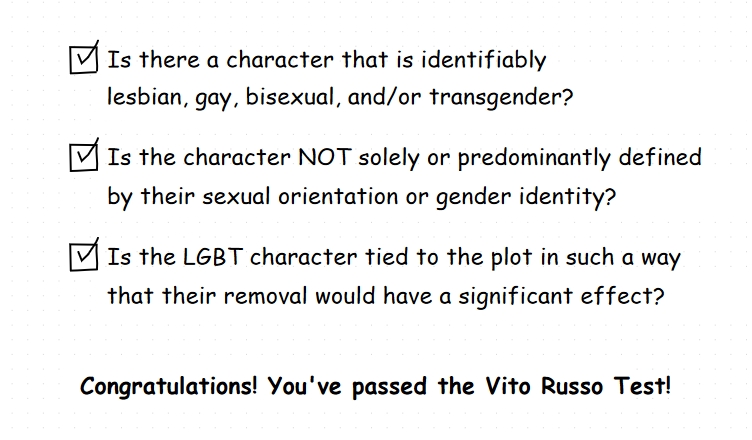
Ethnicity and Race: The People of Colour Test
There are variations on this metric, with some sticking close to the original Bechdel Test formula, while others are more refined. As with the above tests, the idea is to ensure that characters portraying people of colour have depth and richness, as well as a level of reality, rather than adhering to a trope. Also important is avoiding the role of being a token.
Sample 1:
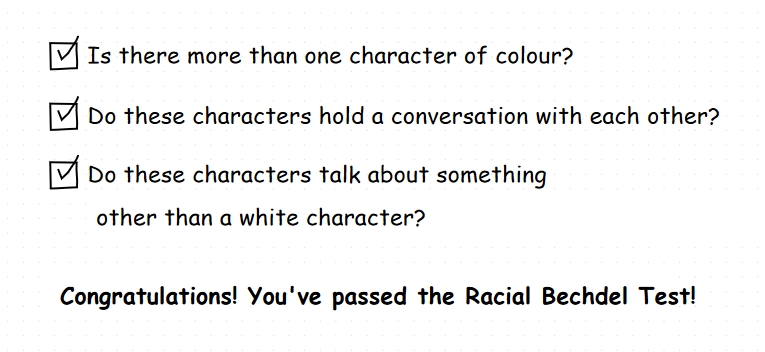
Description taken from The Racial Bechdel Test.
Sample 2:
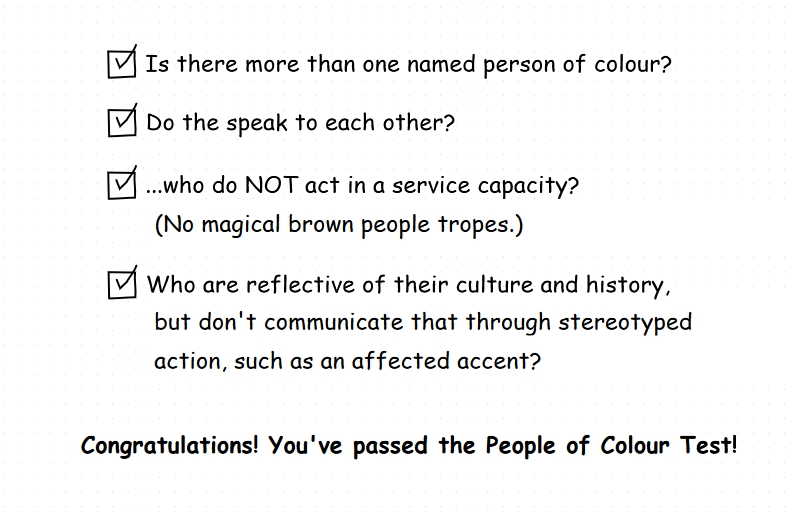
Description taken from Clutch Magazine.
Another consideration is whether or not a character’s name reflects their heritage. Amir Talai points out why this matters in his article, “When A Brown Actor Plays A White Character, Who Really Wins?” “…while it may seem like a victory for a brown actor to play a character with a stereotypically white name, it actually reinforces the idea that complex, multidimensional characters have to read as white, while characters with “brown” names are relegated to roles where we play terrorists named Mohammed or cabbies named Apu.”
Gender Bias in Journalism: The Finkbeiner Test
Although the intended audience for this app is centred in the entertainment industry rather than news media, both fields have communication at their heart. Considering application of guidelines such as those found in the Finkbeiner Test are, therefore, useful.
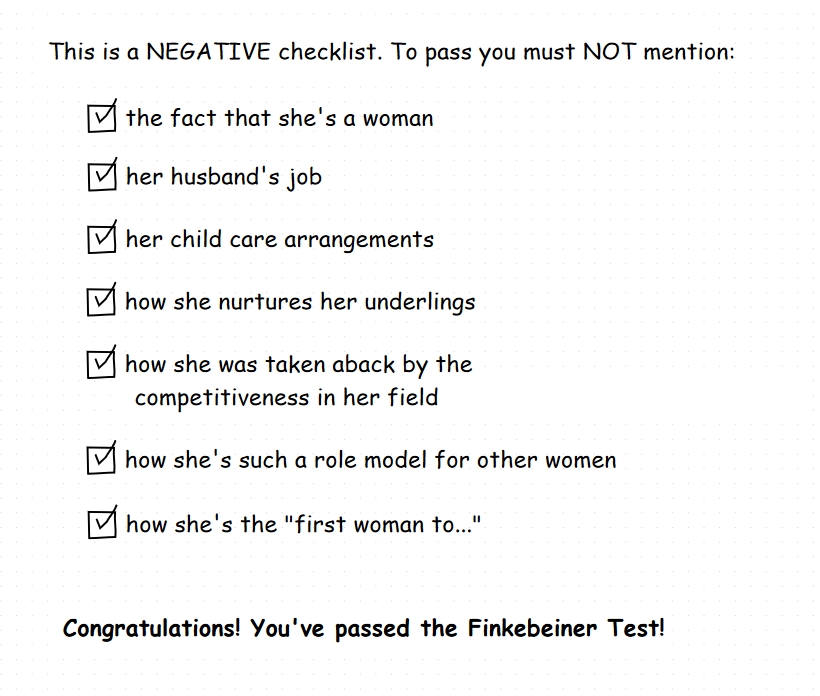
Description taken from Columbia Journalism Review.
It is important to note that the Finkbeiner Test can be adapted like the Bechdel Test for use in communicating about minorities and other oppressed groups. Changing some of the wording to address common stereotypes and tropes about said groups in a variety of situations to parallel the way the current wording addresses stereotypes about women in science can be done on a case by case basis. Intersectionality is a huge part of equality, diversity, and inclusion, and should not be overlooked.
Language Parity
A simple question writers can ask themselves is, “Am I using terms that recognise equal levels of maturity?” Often, the word “man” is used to describe adult males, while “girl” is used to describe adult females. On some level, this suggests that men have reached their majority, while women will forever remain minors. This is known as “infantilisation.”
Another example: in both actual science and science fiction, the term “manned mission” to describe space exploration is frequently used. This is the case even when the crew includes females. A more inclusionary option is “crewed mission”.
Terms such as “manned” and “manpower” are exclusionary and sexist. Replacing commonly used words with gender-neutral terminology is not always easy, but it can nearly always be done. Although there is not a Bechdel Test variation for language equality as it applies to gender, there are some quick checks that can be undertaken:
- search for “girl”; replace with “woman” as appropriate
- search for “manned”, “*man” (wildcard search), and “*men”; if the words returned refer to responsibilities or jobs, rather than people, replace with gender-neutral terms
Some alternatives: staff(ed), crew(ed), operated, run, troops, soldiers. In short, turn the job into a title.
There are examples of neutral titles that do not roll off the tongue, such as “chairperson” or “foreperson”, when one is more used to the “-man” ending. Often using “chair” or “supervisor” is easier. Switching to one term for all genders will, in the end, reduce awkwardness and the exclusionary nature of some atmospheres. It is conceivable that it will reduce the cost of print and décor considerations, as well.
Authenticity
Shortcuts are easy to take. In fact, they are sometimes necessary in the name of time and budget constraints. However, when portraying people outside of our milieu, it is important that representations are done accurately and with respect. One question to ask yourself in reference to the appropriateness of a character’s behaviours and dialogue:
Are cultural references present, not just because of the race or ethnicity, but because they are true to the character and the conversation that is happening?
Circumstances allowing, consulting with members of a represented group, or with an organisation that promotes the welfare of said members, is a good way to get started down the right path. Be prepared to listen well, and do not be afraid to edit mercilessly.
The best approach, of course, is to have members of the represented group as part of the crew, actively participating in story and character creation. In many cases, marginalised people are uncomfortable with speaking up in the face of microagressions and misrepresentation. Creating an atmosphere conducive to dialogue and open exchange is vital.
Behind the Scenes
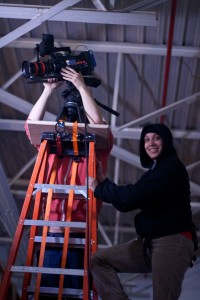 The composition of crew and staff on any creative project have a measurable impact on the final product. This is, of course, the case when it comes to diversity. For example, female directors are more likely to have a higher percentage of women in meaningful roles on screen.
The composition of crew and staff on any creative project have a measurable impact on the final product. This is, of course, the case when it comes to diversity. For example, female directors are more likely to have a higher percentage of women in meaningful roles on screen.
In video games, it can range from avoiding missteps in storylines, seen in “You Can Thank Women For Dragon Age 3’s Lack Of Creepy Sex Plot“, for example, to being more inclusive in character development and story arcs, as seen in ““Straight Male Gamer” Told to “Get over It” by BioWare“. In the former case, there were women on the team who spoke up about something that the men on the team had overlooked. In the latter case, the head writer of the franchise, a gay man, likely found it logical and natural to include LGBTQ characters and romance options. Similarly, involving members of groups who are being portrayed affects the authenticity of the portrayal.
Some of this happens through intention, as with “Building a Character: Cremisius “Krem” Aclassi” (Krem is transgender), and some through happenstance. It’s great when companies consciously plan for diversity – indeed, it is the hope that this very application supports more of this intentionality – but even if the entire organisation is not on board, individuals can often have an impact if they are willing to take a chance. It is particularly useful when hiring managers and other key management individuals have this intention, as the decisions made by gatekeepers can have wide-ranging effects.
Artists and technicians tend to believe that hiring is done mainly on the basis of skill. Yet everyone claims to want innovation, new perspectives, and unique products. At some companies, diversity can be a more important consideration than portfolio alone. Introducing this idea to companies that have not yet embraced it can be eye-opening.
In the film industry, perhaps more than any other business, who you know matters much more than what you know. Most people tend to socialise with others who are like themselves. This makes it even more difficult to break in from the outside.
Questions to Ask:
- of the known people who can fill this role, do any of them fit a description other than “cisgender, white, male”?
- what criteria are we using to hire?
- is our production/company welcoming to people of diverse backgrounds?
- if not, are there any consultants or community groups we can reach out to for help in changing that?
- can hiring managers and other gatekeepers be given higher level training on how to spot candidates who bring unique perspectives, not just a solid work history or portfolio?
- is there a way that job applicants can be encouraged to provide data on diversity factors that define themselves?
These questions, like many other prompts in the app, can be presented in a check box format. Linking to some of the relevant stories from the Anecdotes section, particularly if the speaker is willing to submit a video or other non-written media testimony, about giving chances or being given a chance could be incredibly valuable.
On-Screen
 Who tells the stories, how it’s told, and by whom all affect the overall presentation. For most audiences, the latter is the most important piece because this is what they see.
Who tells the stories, how it’s told, and by whom all affect the overall presentation. For most audiences, the latter is the most important piece because this is what they see.
If a crew or company has been mindful from the start, folding the casting decisions into diversity considerations will not be as difficult as trying to change assumptions near the end of the process. Even so, when large sums of money are involved, fear will sometimes bring out the “tried and true” in opposition of the bold and new.
Film studios make many of their decisions – whether or not to greenlight a project, how to plan the budget, how much money to invest in marketing, etc. – based on who is playing the leading roles. If an “A list” star, someone who is “bankable”, is cast in the lead role, confidence in success of the endeavour is higher. Casting an unknown is seen as risky. Yet it is exactly this kind of thinking that has led to a stagnation in the industry, leaving audiences with predictable (read: safe) fare like sequels and endless reboots.
Geena Davis recommends that just after a script is completed (or at least a draft, as some revisions carry on well into the production process), the writer go back through and make sure that half of the characters are female. She suggests this because half of the world’s population is female, so representing that is logical and fair. This suggestion can be expanded to include any number of markers for diversity, depending on the story being told. Grey’s Anatomy was cast on a “colourblind” basis, allowing for greater on-screen diversity and a more accurate picture of the American populations.
Some questions casting directors can ask themselves:
- how can I accurately represent the population described in the story through casting choices?
- if the story is about a particular race or ethnicity, how can I avoid cultural appropriation?
- are the lead roles being played by actors of the correct ethnicity, gender, age, ability, etc.? if not, is there anything I can do to influence the decision?
- are older men being paired with much younger women? if so, can the age gap be narrowed or eliminated?
- are there any relatively unknown actors of diverse ethnic backgrounds who can be cast?
Obviously, there are a great number of considerations that go into casting, yet we often end up with older white men and younger white women in roles that would more appropriately gone to other performers. Sometimes it’s a case of studio safety and “bankability”, while other times it is simply not questioning the status quo. If these suggestions can encourage those involved in the casting process to ask important questions, we can begin to advance the cause of diversity in small but important ways.
Personal Story Submissions
 Users, interviewees, and website visitors are invited to submit stories and anecdotes about how diversity issues have, for good or ill, impacted their lives. This section was suggested by a thesis interviewee and was enthusiastically supported by subsequent interviewees. Numbers and statistics are important, but they are cold and unrelatable. The human element – empathy – is what really makes the information real.
Users, interviewees, and website visitors are invited to submit stories and anecdotes about how diversity issues have, for good or ill, impacted their lives. This section was suggested by a thesis interviewee and was enthusiastically supported by subsequent interviewees. Numbers and statistics are important, but they are cold and unrelatable. The human element – empathy – is what really makes the information real.
Stories are meant to be short and easily digested. Some will make a distinct point, others will merely be observations. There will be editing for style and consistency for the application, but it is up to the person submitting to choose tone and angle. Tone will only be adjusted if it appears that one of the aims of the story is defamatory; indeed, those stories may not be accepted at all.
As with the thesis, users will have the option of including personally identifiable information or remaining anonymous. It is envisioned as being in a similar format to a fan submission site on Tumblr, Dragon Age Confessions. There will be a disclaimer explaining that none of the stories have been verified. Other sources of inspiration for format come from StoryCorps, with their short audio pieces, telling poignant and unusual tales.
The samples below are taken from interviews. They provide a glimpse into content types, if not tone, as they were not written by the speakers themselves.
The Fortune Cookie
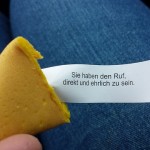 Shi Kai Wang says he has not been on the receiving end of any noticeable, direct prejudice, but that colleagues who are not culturally aware have been known to make ignorant statements. Once at an expo where his company was promoting a game with a Japanese, female protagonist, his colleagues were trying to come up with ideas for party favours. One of them suggested fortune cookies, completely unaware of how incorrect the suggestion that was for the culture. “People don’t care how they appropriate ethnic [symbols]… if it serves their needs, it’s totally fine.”
Shi Kai Wang says he has not been on the receiving end of any noticeable, direct prejudice, but that colleagues who are not culturally aware have been known to make ignorant statements. Once at an expo where his company was promoting a game with a Japanese, female protagonist, his colleagues were trying to come up with ideas for party favours. One of them suggested fortune cookies, completely unaware of how incorrect the suggestion that was for the culture. “People don’t care how they appropriate ethnic [symbols]… if it serves their needs, it’s totally fine.”
He does notice his physical characteristics – not as tall as nor possessing a “boomy voice” – are not representative of the average employee. Generally, Wang does not object to representations of Asian people in video games – “It’s a made up, fantasised world…” – and points out that even in Korean and Japanese games the characters do not look Asian. “Even games that tried to do it right, like Mirror’s Edge, still got scrutiny.”
Shipping the Beta
 Ingrid Carlson is a software engineer. She has worked in positions of authority for many years, some where her expertise was respected, others where she was routinely dismissed and disrespected. In an example of the latter, during her first week on a new job in a department where she was the only women, a beta version of the product was set to go out. In the meeting, her supervisor announced to the group, “[We are] shipping a beta …pants down, balls are on the table.”
Ingrid Carlson is a software engineer. She has worked in positions of authority for many years, some where her expertise was respected, others where she was routinely dismissed and disrespected. In an example of the latter, during her first week on a new job in a department where she was the only women, a beta version of the product was set to go out. In the meeting, her supervisor announced to the group, “[We are] shipping a beta …pants down, balls are on the table.”
In a further, and even more aggressive, example of sexism, Carlson was called to attend a meeting about a topic in which she was not only extremely knowledgeable, but was, in fact, the resident expert. She was told very directly to “shut up and not say a word.” The other engineers in the room were male. As the meeting progressed, it became obvious that they didn’t know how to handle the situation they’d been called in to address, so Carlson spoke up. After the meeting, her boss pulled her aside and said, “I told you to be quiet.” She has not gone to Human Resources about this.
Artist's Perspective
 Jason Murray is an artist in the video game industry. He has worked at several visual effects and gaming studios across the United States. At one company, while working with a small team, an artist was brought in for an interview. The applicant was male-to-female transgender, relatively early in her transition. This was something that she brought up herself.
Jason Murray is an artist in the video game industry. He has worked at several visual effects and gaming studios across the United States. At one company, while working with a small team, an artist was brought in for an interview. The applicant was male-to-female transgender, relatively early in her transition. This was something that she brought up herself.
Murray was excited to potentially have her on the team both because she is an amazing artist and because he thought she would bring a unique perspective. He also felt it was a really positive thing to interview someone from the transgender community but not have it be a big deal. The position was offered to her, but she ended up declining.
As with other features, this section will update if and when the user synchronises the application.
What is Happening Now
This section of the app will show either current (streaming) news updates or cached content, depending on the user’s preferences. Cached content can be set to update automatically once the device is connected to the internet via WiFi and (if enabled) data, or to only collect new content upon a manual request. The idea is that it will work similarly to podcast applications, like Podcast Addict: download an updated index of available podcasts and stream only when connected, or download full episodes in order to make them available offline.
While connected, users will have the option of viewing live updates of hashtags from popular social media services such as Twitter, Facebook, Instagram, and Google Plus.
Similarly, news aggregate or custom curation sites can be included.
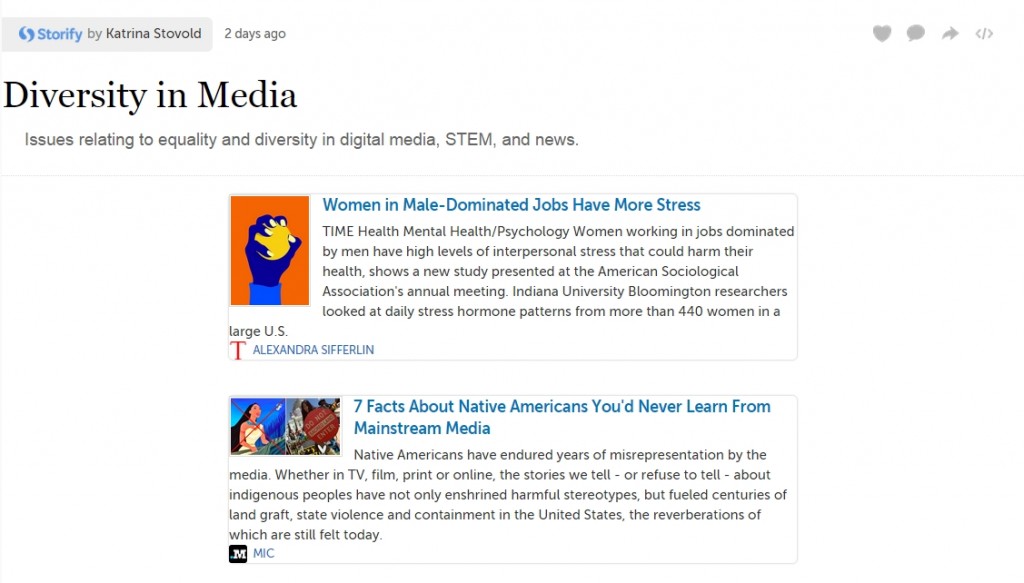
View live version here.
The question of what content to include – and who will curate it, if anyone – is a good one. For early versions, sticking with simple hashtags such as #diversity and #equality may be the best approach. Basic curation by the author, as demonstrated in the Storify section above, may also be included. As the app gets more advanced, it’s possible that APIs (application program interface) from popular services can be integrated, allowing for more customisation by the user. This will be particularly useful in the case of trending news.
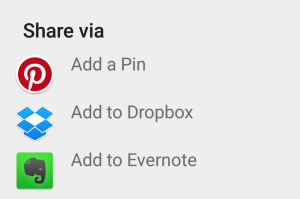
Connected sharing or “view later” services and functions will depend on which other applications the user has installed. Some examples are Facebook, Twitter, email, Pocket, Evernote, Pinterest, Dropbox, Bluetooth, and Copy to Clipboard, among others.
Reference Material
 Material in this section is meant to be supportive of main points made elsewhere. The articles are a mixture of academic and business writing, contemporary news articles, and links to organisations that provide statistics and community support. Initially, there will be overlap between this section and the News section. As time passes, however, this section will become more static as compared to the News section. This is meant to provide solid examples of situations and definitions that can be referenced again and again, while News is meant to be current and dynamic.
Material in this section is meant to be supportive of main points made elsewhere. The articles are a mixture of academic and business writing, contemporary news articles, and links to organisations that provide statistics and community support. Initially, there will be overlap between this section and the News section. As time passes, however, this section will become more static as compared to the News section. This is meant to provide solid examples of situations and definitions that can be referenced again and again, while News is meant to be current and dynamic.
Discrimination
Australian TV Host Wears Same Suit for a Year and Nobody Notices
BBC Failing Ethnic Minority Staff, Says Black Journalist
Are Emily and GregMore Employable than Lakisha and Jamal? A Field Experiment on Labor Market Discrimination
Driving While Black: Racial Profiling On Our Nation’s Highways
Gender Bias Without Borders – the Geena Davis Institute on Gender in Media
Learning from Our Oppression: What Transgender Microaggressions Can Teach Us About Our Friends and Each Other (.pdf)
Panel Discussion: Dawkins, Tyson, Druyan, Stenger, Grothe – Neil deGrasse Tyson – (video: begin at 1:01:30)
Paul Piff: Does Money Make You Mean? – TED Talk
Performance Review Gender Bias: High-Achieving Women Are “Abrasive” – Fortune
Prejudice Is Hard-Wired Into The Human Brain, Says ASU Study
Sheryl Sandberg and Adam Grant on Why Women Stay Quiet at Work – NYTimes
Sheryl Sandberg and Anna Maria Chávez on “Bossy,” the Other B-Word – WSJ
Gender Disparity On Screen and Behind the Camera in Family Films; The Executive Report (.pdf) – Geena Davis Institute on Gender in Media
Stam, Robert, and Louise Spence, ‘Colonialism, Racism and Representation – Academia.edu (Note: partial paper; full text available for purchase.)
The One Word Men Never See In Their Performance Reviews – Fast Company
What Happens Now?
 The plan for this application has always been to develop it more fully during the course of studies for a Ph.D. Moreover, it is meant to be flexible, expandable, and customisable for niche markets. As more interviews are conducted and contacts made, more specialised sections, questions, answers, and algorithms can be developed. Different versions of the application may be considered for different industries, including those that have nothing to do with entertainment.
The plan for this application has always been to develop it more fully during the course of studies for a Ph.D. Moreover, it is meant to be flexible, expandable, and customisable for niche markets. As more interviews are conducted and contacts made, more specialised sections, questions, answers, and algorithms can be developed. Different versions of the application may be considered for different industries, including those that have nothing to do with entertainment.
It is hoped that the author will either be able to develop the skills necessary to program an initial version of the application herself, or that funding will become available which will allow an established app designer to be hired. In the case of the former, the first platform developed will be Android, due to licensing and availability of equipment and tools. If an established designer can be hired, however, iOS may be developed first, due to the relative uniformity of the requirements for the platform, as well as visibility and popularity within academic circles.
Whether or not the application becomes a reality, this website will be maintained for at least the next several years.
 Here users will be given the opportunity to select their personal descriptors in order to address the issue of implicit bias. By identifying some things that typically affect our perceptions of the world, these issues can be brought into focus and examined.
Here users will be given the opportunity to select their personal descriptors in order to address the issue of implicit bias. By identifying some things that typically affect our perceptions of the world, these issues can be brought into focus and examined. The composition of crew and staff on any creative project have a measurable impact on the final product. This is, of course, the case when it comes to diversity. For example, female directors are more likely to have a higher percentage of women in meaningful roles on screen.
The composition of crew and staff on any creative project have a measurable impact on the final product. This is, of course, the case when it comes to diversity. For example, female directors are more likely to have a higher percentage of women in meaningful roles on screen. Who tells the stories, how it’s told, and by whom all affect the overall presentation. For most audiences, the latter is the most important piece because this is what they see.
Who tells the stories, how it’s told, and by whom all affect the overall presentation. For most audiences, the latter is the most important piece because this is what they see. Users, interviewees, and website visitors are invited to submit stories and anecdotes about how diversity issues have, for good or ill, impacted their lives. This section was suggested by a thesis interviewee and was enthusiastically supported by subsequent interviewees. Numbers and statistics are important, but they are cold and unrelatable. The human element – empathy – is what really makes the information real.
Users, interviewees, and website visitors are invited to submit stories and anecdotes about how diversity issues have, for good or ill, impacted their lives. This section was suggested by a thesis interviewee and was enthusiastically supported by subsequent interviewees. Numbers and statistics are important, but they are cold and unrelatable. The human element – empathy – is what really makes the information real.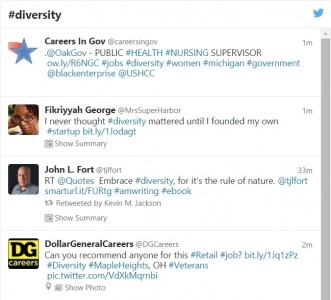
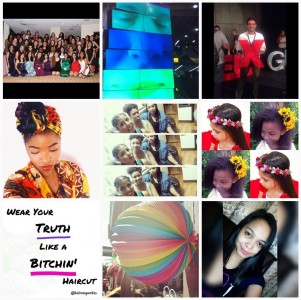
 Material in this section is meant to be supportive of main points made elsewhere. The articles are a mixture of academic and business writing, contemporary news articles, and links to organisations that provide statistics and community support. Initially, there will be overlap between this section and the News section. As time passes, however, this section will become more static as compared to the News section. This is meant to provide solid examples of situations and definitions that can be referenced again and again, while News is meant to be current and dynamic.
Material in this section is meant to be supportive of main points made elsewhere. The articles are a mixture of academic and business writing, contemporary news articles, and links to organisations that provide statistics and community support. Initially, there will be overlap between this section and the News section. As time passes, however, this section will become more static as compared to the News section. This is meant to provide solid examples of situations and definitions that can be referenced again and again, while News is meant to be current and dynamic. The plan for this application has always been to develop it more fully during the course of studies for a Ph.D. Moreover, it is meant to be flexible, expandable, and customisable for niche markets. As more interviews are conducted and contacts made, more specialised sections, questions, answers, and algorithms can be developed. Different versions of the application may be considered for different industries, including those that have nothing to do with entertainment.
The plan for this application has always been to develop it more fully during the course of studies for a Ph.D. Moreover, it is meant to be flexible, expandable, and customisable for niche markets. As more interviews are conducted and contacts made, more specialised sections, questions, answers, and algorithms can be developed. Different versions of the application may be considered for different industries, including those that have nothing to do with entertainment.












